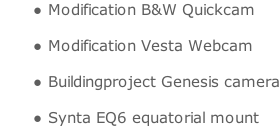



Copyright © All rights reserved. Made By Erik Bryssinck Terms of use | Privacy policy














|
Observation date |
image |
Photometry (FOCAS) |
Afρ |
astrometry |
Observatory |
|
X |
X |
|
X |
B96 (BRIXIIS) |
|
|
X |
X |
|
X |
B96 (BRIXIIS) |
|
|
|
|
|
|
|
|
|
|
|
|
|
|
|
comet 274P/TOMBAUGH-
Photometric data obtained by use of FOCAS-
10x10 20x20 30x30 40x40 50x50 60x60 SNR SB COD
OBJECT DATE TIME +/-
-
274P 11/01/2013 23:37:04 17.12 16.59 16.29 16.09 16.10 9.7 18.1 B96
274P 11/01/2013 23:37:04* 0.04 0.08 0.12 0.10 0.10 4 3.2 USN
274P 14/03/2013 20:15:26 17.61 16.75 16.27 16.07 16.07 4.1 17.9 B96
274P 14/03/2013 20:15:26* 0.21 0.17 0.07 0.01 0.06 3 3.5 CMC
Discovery:
comet C/1931 AN was discovered by C.W. Tombaugh (Lowel Observatory, Arizona, USA) on plates taken by the 0.33-
Recovery:
An asteroid was discovered at the Tenagra II observatory by Michael Schwartz and Paulo Holvorcem with the 0.41m astrograph on November 27.50. On December 3 they noted cometary features during follow-
Syuichi Nakano then linked the comet to asteroid 2003 WZ141 which was observed by Spacewatch and LINEAR in 2003, and to a comet discovered by Clyde Tombaugh in 1932 on plates taken in 1931 January and which was originally logged as asteroid 1931 AN. Details of the chain of events surrounding 1931 AN are given by Gary Kronk in Volume 3 of Cometography. Gareth Williams then computed an orbit linking the three apparitions. The new orbit is very different to that calculated for 1931 AN, largely on account of large errors in the position from the first of its three plates. The new orbit has the 1931 perihelion at 2.4 AU cf the 0.9 AU calculated from four positions, and is periodic rather than parabolic. The current period is 9.1 years, and this is the 10th return, reaching perihelion in 2013 February. It seems likely that the comet may have outburst in 1931, as it was estimated at 12th magnitude on the plates, some 6 magnitudes brighter than suggested by the ephemeris. Alternatively it may have a linear type light curve.